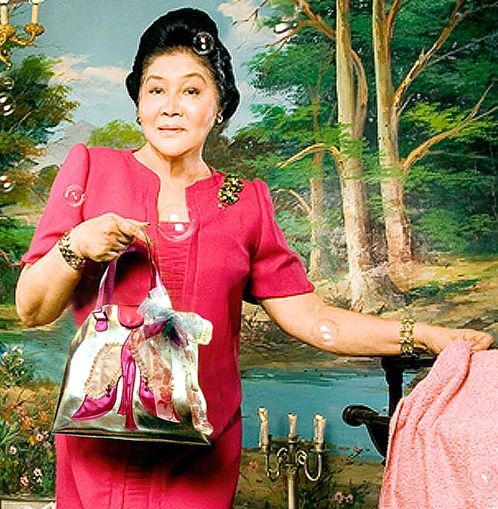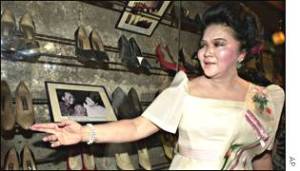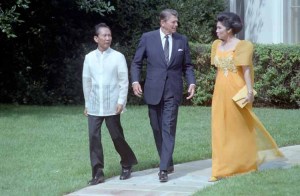
Yellow - Former President Corazon Aquino's favorite color - was all around Metro Manila on Saturday as the nation mourned the death of its beloved first female president and hero of the People Power revolt that restored democracy in the country. Even streetsweepers went about their chores with yellow ribbons tied around their heads in respect to "Cory" Aquino.
“She was headstrong and single-minded in one goal, and that was to remove all vestiges of an entrenched dictatorship,” Raul C. Pangalangan, former dean of the Law School at the University of the Philippines, said earlier this month. “We all owe her in a big way.”
Her son, Sen. Benigno “Noynoy” or Aquino III, said his mother died at 3:18 a.m. Saturday (1918 GMT Friday).
Aquino was diagnosed with advanced colon cancer last year and confined to a Manila hospital for more than a month. Her son said the cancer had spread to other organs and she was too weak to continue her chemotherapy.
Supporters have been holding daily prayers for Aquino in churches in Manila and throughout the country for a month. Masses were scheduled for later Saturday, and yellow ribbons were tied on trees around her neighborhood in Quezon city.
President Gloria Macapagal Arroyo, who is on an official visit to the United States, said in a statement that “the entire nation is mourning” Aquino’s demise. Arroyo declared a period of national mourning and announced a state funeral would be held for the late president.
TV stations on Saturday were running footage of Aquino’s years together with prayers while her former aides and supporters offered condolences.
“Today our country has lost a mother,” said former President Joseph Estrada, calling Aquino “a woman of both strength and graciousness.”
Even the exiled Communist Party founder Jose Maria Sison, whom Aquino freed from jail in 1986, paid tribute from the Netherlands.
Aquino’s unlikely rise began in 1983 when her husband, opposition leader Benigno “Ninoy” Aquino Jr., was assassinated on the tarmac of Manila’s international airport as he returned from exile in the United States to challenge Marcos, his longtime adversary.
The killing enraged many Filipinos and unleashed a broad-based opposition movement that thrust Aquino into the role of national leader.
“I don’t know anything about the presidency,” she declared in 1985, a year before she agreed to run against Marcos, uniting the fractious opposition, the business community, and later the armed forces to drive the dictator out.
Maria Corazon Cojuangco was born on Jan. 25, 1933, into a wealthy, politically powerful family in Paniqui, about 75 miles (120 kilometers) north of Manila.
She attended private school in Manila and earned a degree in French from the College of Mount St. Vincent in New York. In 1954 she married Ninoy Aquino, the fiercely ambitious scion of another political family. He rose from provincial governor to senator and finally opposition leader.
Marcos, elected president in 1965, declared martial law in 1972 to avoid term limits. He abolished the Congress and jailed Aquino’s husband and thousands of opponents, journalists and activists without charges. Aquino became her husband’s political stand-in, confidant, message carrier and spokeswoman.
A military tribunal sentenced her husband to death for alleged links to communist rebels but, under pressure from U.S. President Jimmy Carter, Marcos allowed him to leave in May 1980 for heart surgery in the U.S.
It was the start of a three-year exile. With her husband at Harvard University holding court with fellow exiles, academics, journalists and visitors from Manila, Aquino was the quiet homemaker, raising their five children and serving tea. Away from the hurly-burly of Philippine politics, she described the period as the best of their marriage.

Benigno (Ninoy) Aquino, Corazon Aquino's husband, was the leader of the Filipino opposition to Ferdinand Marcos. He was shot dead in 1983 as he returned to the Philippines.
The halcyon days ended when her husband decided to return to regroup the opposition. While she and the children remained in Boston, he flew to Manila, where he was shot as he descended the stairs from the plane.
The government blamed a suspected communist rebel, but subsequent investigations pointed to a soldier who was escorting him from the plane on Aug. 21, 1983.
Aquino heard of the assassination in a phone call from a Japanese journalist. She recalled gathering the children and, as a deeply religious woman, praying for strength.
“During Ninoy’s incarceration and before my presidency, I used to ask why it had always to be us to make the sacrifice,” she said in a 2007 interview with The Philippine Star newspaper. “And then, when Ninoy died, I would say, ‘Why does it have to be me now?’ It seemed like we were always the sacrificial lamb.”
She returned to the Philippines three days later. One week after that, she led the largest funeral procession Manila had seen. Crowd estimates ranged as high as 2 million.
With public opposition mounting against Marcos, he stunned the nation in November 1985 by calling a snap election in a bid to shore up his mandate. The opposition, including then Manila Archbishop Cardinal Jaime L. Sin, urged Aquino to run.
After a fierce campaign, the vote was held on Feb. 7, 1986. The National Assembly declared Marcos the winner, but journalists, foreign observers and church leaders alleged massive fraud.

Ferdinand Marcos was elected president of the Philippines in 1965. In 1972 he imposed martial law and seized dictatorial powers. A massive four-day protest known as the People Power Movement forced him from office in 1986 and restored democracy in the Philippines.
With the result in dispute, a group of military officers mutinied against Marcos on Feb. 22 and holed up with a small force in a military camp in Manila.
Over the following three days, hundreds of thousands of Filipinos responded to a call by the Roman Catholic Church to jam the broad highway in front of the camp to prevent an attack by Marcos forces.
On the third day, against the advice of her security detail, Aquino appeared at the rally alongside the mutineers, led by Defense Minister Juan Ponce Enrile and Lt. Gen. Fidel Ramos, the military vice chief of staff and Marcos’ cousin.
From a makeshift platform, she declared: “For the first time in the history of the world, a civilian population has been called to defend the military.”
The military chiefs pledged their loyalty to Aquino and charged that Marcos had won the election by fraud.
U.S. President Ronald Reagan, a longtime supporter of Marcos, called on him to resign. “Attempts to prolong the life of the present regime by violence are futile,” the White House said. American officials offered to fly Marcos out of the Philippines.
On Feb. 25, Marcos and his family went to the U.S.-run Clark Air Base outside Manila and flew to Hawaii, where he died three years later.
The same day, Aquino was sworn in as the Philippines’ first female leader.

President Ronald Reagan and Philippine President Corazon Aquino meet on September 17, 1986 in the Oval office of the White House in Washington.
Over time, the euphoria fizzled as the public became impatient and Aquino more defensive as she struggled to navigate treacherous political waters and build alliances to push her agenda.
“People used to compare me to the ideal president, but he doesn’t exist and never existed. He has never lived,” she said in the 2007 Philippine Star interview.
The right attacked her for making overtures to communist rebels and the left, for protecting the interests of wealthy landowners.
Aquino signed an agrarian reform bill that virtually exempted large plantations like her family’s sugar plantation from being distributed to landless farmers.
When farmers protested outside the Malacanang Presidential Palace on Jan. 22, 1987, troops opened fire, killing 13 and wounding 100.
The bloodshed scuttled talks with communist rebels, who had galvanized opposition to Marcos but weren’t satisfied with Aquino either.
As recently as 2004, at least seven workers were killed in clashes with police and soldiers at the family’s plantation, Hacienda Luisita, over its refusal to distribute its land.
Aquino also attempted to negotiate with Muslim separatists in the southern Philippines, but made little progress.
Behind the public image of the frail, vulnerable widow, Aquino was an iron-willed woman who dismissed criticism as the carping of jealous rivals. She knew she had to act tough to earn respect in the Philippines’ macho culture.
“When I am just with a few close friends, I tell them, ‘OK, you don’t like me? Look at the alternatives,’ and that shuts them up,” she told America’s NBC television in a 1987 interview.
Her term was punctuated by repeated coup attempts — most staged by the same clique of officers who had risen up against Marcos and felt they had been denied their fair share of power. The most serious attempt came in December 1989 when only a flyover by U.S. jets prevented mutinous troops from toppling her.
Leery of damaging relations with the United States, Aquino tried in vain to block a historic Senate vote to force the U.S. out of its two major bases in the Philippines.
In the end, the U.S. Air Force pulled out of Clark Air Base in 1991 after the eruption of Mount Pinatubo forced its evacuation and left it heavily damaged. The last American vessel left Subic Bay Naval Base in November 1992.

former First Lady of the Philippines Imelda Marcos debuts her new line of accessories, 2006
After stepping down in 1992, Aquino remained active in social and political causes.Until diagnosed with colon cancer in March 2008, she joined rallies calling for the resignation of President Arroyo over allegations of vote-rigging and corruption.
Marcos has called Aquino a usurper and dictator, though she later led prayers for Aquino in July 2009 when the latter was hospitalized. The two never made peace.
Look under “Categories” in column at right.



































